
When you want to get more of your favorite vintage dishes, but don’t know the pattern name, what to do? Identifying vintage dinnerware is one of the challenges of using vintage dishes.
Whether you have new-to-you-dishes, or a family heirloom set, getting more of a pattern you cherish can be complicated when you don’t have a pattern name.
Recently I saw an article about a woman in Philadelphia, known for being a taste-setter in her area. The article showed that she used many modern elements in her style, with the addition of vintage dinnerware from her husband’s family.
Then the article described the two vintage floral china patterns, but didn’t give the pattern names.
The challenge is presented - bring on the dishes
Almost as much fun as the thrill of the hunt, the challenge of identifying vintage dinnerware, in this case only from photos and written descriptions.
(I’ve never had either of these patterns in my store, by the way, so I didn’t have that edge.)
I focused on the hunt online, and had both pattern names in less than 6 minutes.
Believe me, it does not always go this fast, and there are patterns that I have never found, despite lots more time spent searching.
How to approach identifying vintage dinnerware
The first pattern was described as pink floral with gray leaves, made in Japan. No maker name. In the photo, I saw there was also a gray scroll motif in the rim, which seemed vaguely familiar.
This pattern took longest to find. I went to a favorite replacement dinnerware site, and put in “Japan pink floral gray” as my keywords.
I went through the wares of two different vintage Japanese makers (dinner plates only). The match was under Unknown maker. The pattern name: Elaine.
Why would the maker remain unknown? I cannot be sure, but can speculate that the dinnerware was commissioned by a retail store, to be their exclusive pattern. There are other possibilities.
The second pattern was described as having a central spray of blue flowers and was marked with the maker name, Syracuse. In the photo, I noted that the dinner plate had a blue rim. I searched on “Syracuse blue rim” and the Meadow Breeze pattern came up quickly.
Tips to identify vintage dinnerware patterns
- One thing I’ve learned from looking at floral dinnerware patterns, most of the time, the flowers and leaves are stylized. The artist took considerable license with nature when creating these whimsical floral designs.
Unless you’re looking at a pattern with roses, daisies (such as the Marguerite bowl in the photo), tulips, daffodils or another well-known flower, just use “floral” in your search.
- Knowing the difference between rim shapes and coupe shapes is also helpful. Coupe pieces are sleek and have no rim around the edge, unlike the more traditional rim shape pieces.
- The country of manufacture can also be helpful, as it was for the Elaine pattern china. Some manufacturers made dinnerware in many countries, even pieces in the same pattern. But when you need that pattern name, a country of origin can be the puzzle piece that helps you find it.
Identifying vintage dinnerware is fun and practical. If you’re looking for more pieces for a special vintage dinnerware set, or found a piece or two of a pattern blends well with your mix and match dish collection and want more, having the pattern name makes finding them far more efficient.
About the photos: Yellow floral pattern is Marguerite by Noritake. The daisies are prominent. This pattern is generally marked with the pattern name, on the larger pieces.
The relish dish with a floral vine motif is also Noritake. I have not found a name for this pattern in more than three years. It is marked with maker name and a number, 1384. I can tell by the shapes that it’s vintage. This china may have been commissioned for a particular department store.
The gravy boat is Polaris by Syracuse. It is marked with the maker name. This piece is the same shape as the gravy boat in the Meadow Breeze pattern, discussed above, just decorated with different background glaze and motif.
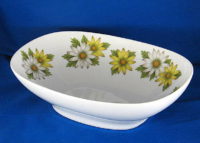
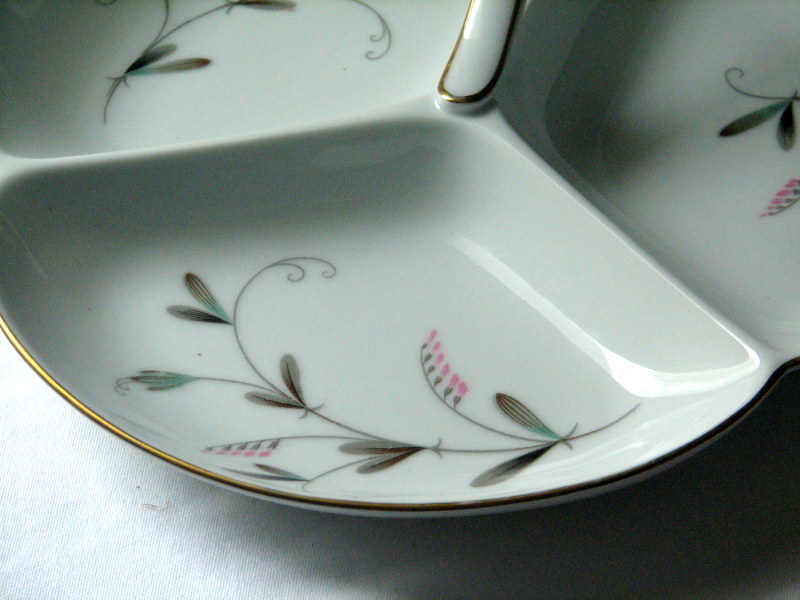
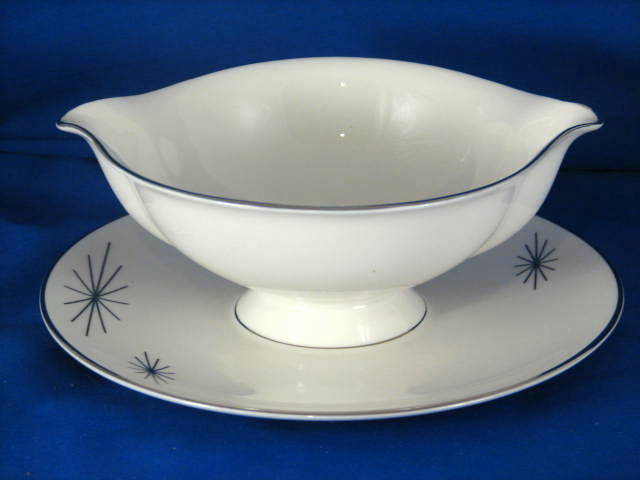
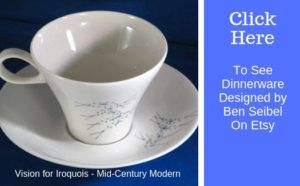

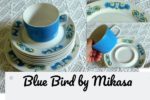
Hello! I’m Jamie with Noritake, and wanted to let you know that if there isn’t a name on the back of the pattern, it probably wasn’t named. However, if you post a photo of the backstamp on our Facebook page, we can certainly give you the years that backstamp was active, so that you can estimate the pattern’s age. Love your blog!
Our Facebook: http://www.facebook.com/noritakechina
Thanks Jamie!
I’ll certainly take you up on your offer about the backstamps. I’ve got two good candidates already!
I am searching for a pattern name so I can replace a broken cake plate of sentimental value. I knew the name at one time but it won’t come back to me. The cake plate was an accessory from a 40s set that came in bright colors. I believe the colors were yellow ( which was the color of the cake plate) blue, green and orange. The colors were bright and similar to fiesta. The plate was more delicate and was handled and had an elongated scalloped edge. I have a picture in a text but can’t seem to copy it. I will however if the picture will help but I have a feeling you will recognize my description. Thanks so much for your help.
Hello Nancy!
I did a little looking, but did not come up with a pattern that I thought would match. Do you happen to remember the maker, or whether this dinnerware is American or European?
Thanks!
Hi. I’ve inherited a dinner set that nana always told mum was noritake, but now I have my grubby hands on it (!!) its nit stamped as such. I’m having such a hard time identifying the pattern. Its missing a cup.
Can you help me?
If you can post photos on Facebook, I’ll see if I can find any more info. One of the cup, and one of the marks would help. Early Noritake marks include an M instead of the word Noritake.
Obviously, not with the complete absence of actual identifying information. Can I send you a pic?
I have a crooksville pattern of pink flowers (not roses), the pattern also includes wheat
Hello Shannon,
If you take a look at a pattern called Tiffany by Crooksville, you may find what you are looking for. I’m not sure if this one has wheat or a cattail, but there is something that is out of the ordinary, and interesting, about this pattern.
I hope this helps you find what you are looking for!
Hello
I have some dishes that belonged to my grandmother there is no stamps except on the cup which has USA on it the dishes are white with several branches of vine on it with small pink flowers any help would be greatly appreciated
Hello Marcella!
Dinnerware going back decades, when marking was uncommon, is a challenge to identify. You might take a look at Sweet Pea by Homer Laughlin and see if that’s the one you’re looking for. Another maker is called Royal (USA), though I did not find a pattern that sounds like your vines with pink flowers.
Hope this helps!